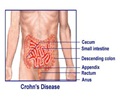
Is JAK Inhibition the Most Promising Agent in Crohn’s Disease Pipeline?
It did not show improvement over the placebo in clinical remission and endoscopic response in its two induction studies. The results are expected to shift the attention of the late-stage CD treatment from established drug classes such as the Janus kinase towards developing novel CD therapeutic targets. Among the 19 assets in late-stage clinical development, only six (ozanimod, etrasimod, obefazimod, TEV-48574, PRA-023, PF-0648065) are being pursued as first-in-class for novel therapeutic targets in CD. Of particular interest are the developing S1PR agonists (ozanimod, etrasimod), specifically, Zeposia (ozanimod) developed by Bristol Myers Squibb (BMS).‘Jyseleca failure in Crohn’s disease treatment will shift the pipeline attention to novel targets.’
Tweet it Now
Already approved to treat adults with multiple sclerosis (MS), Zeposia is being evaluated in pediatric CD patients, in addition to adult patients with an inadequate response to standard-of-care therapies, including anti-tumor necrosis factor (TNF)-naïve patients.If shown to be effective in the anti-TNF naïve patient population, Zeposia could be added as a viable alternative to anti-TNFs and be established as a second-line option. Additionally, S1PR agonists are administered orally, a clear advantage for patient preference over the injections and infusions of biologics.
Future of Drugs Used in Crohn’s Disease
It should also be noted that with the loss of first-in-class status, newer treatments must overcome, not only the natural assurance healthcare providers have acquired with established treatments, but also the obstacle of generics and biosimilars within the drug class. Additionally, the presence of generics may unproportionally affect newer therapies.For example, the launch of Amgen’s Amjevita, the biosimilar to AbbVie’s Humira (adalimumab), is a significant event within the CD and inflammatory bowel disease (IBD) market but may not have as large an effect on AbbVie’s market position due to the steps taken by AbbVie in preparation for the eventual loss of exclusivity for Humira, developing Rinvoq (upadacitinib) and Skyrizi (risankizumab) as the apparent heirs for Humira within immunology.
These strategic steps allow AbbVie to shift focus and resources from its legacy asset to these alternative options. Also, it should be expected that AbbVie has and will utilize its relationships with healthcare payers and pharmacy benefit managers (PBMs) to mitigate the losses from the introduction of the adalimumab biosimilar.
However, the generic does force newer anti-TNFs to show significant improvement over adalimumab to justify their use and cost over Amjevita.
Advertisement
Advertisement












